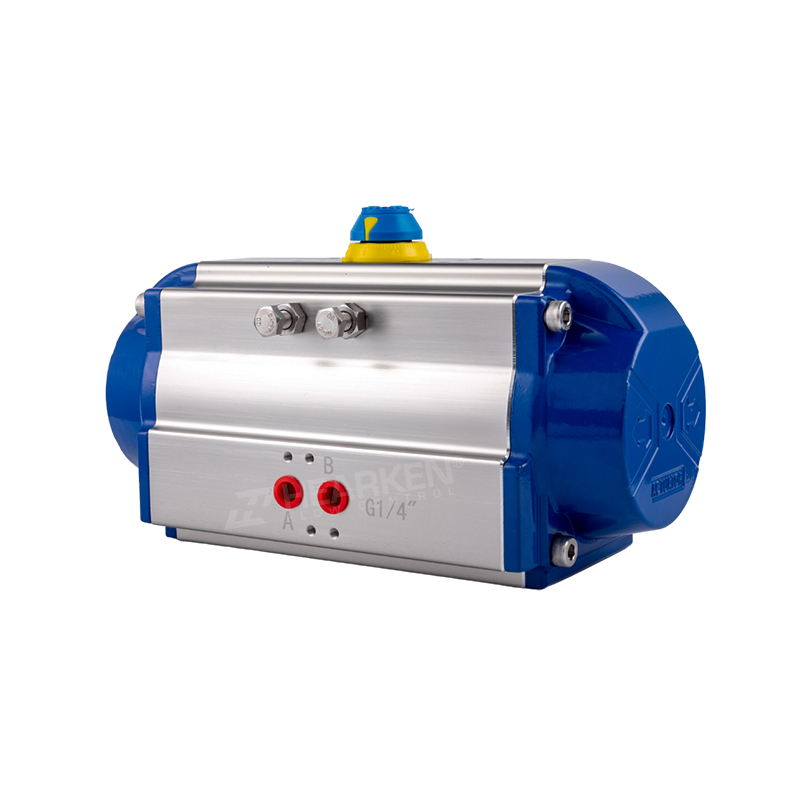Quarter Turn Pneumatic Actuator
HPA Rack & Pinion Pneumatic Actuator With Handwheel
Pneumatic actuator is prelubricated and tested to a min onemillion operations Actuators
180 Degree Rotary Pneumatic Actuator
180 Degree Rotary Pneumatic Actuator
Rack and Pinion Pneumatic Actuator
The cylinder body of the pneumatic actuator is made of extruded aluminum alloy and is tr
Pneumatic Actuator with Limit Switch Box
The rack-and-pinion pneumatic actuator has the advantages of simple structure, stable an
What is a quarter turn actuator?
In the technical tongue, a quarter turn actuator is a device designed to rotate a valve or other type of flow control mechanism a quarter turn, or 90 degrees, to open or close the passage of fluids or gases. This type of actuator is the bread and butter for ball valves, butterfly valves, and plug valves, enabling them to perform their duties with efficiency and reliability.
What is the difference between quarter turn and multi turn actuators?
Quarter Turn Actuators:
- Functionality: Designed to rotate a valve or damper through a 90-degree movement to open or close the flow path.
- Application: Commonly used with ball valves, butterfly valves, and plug valves.
- Operation Speed: Typically offer rapid operation, suitable for applications requiring quick open/close actions.
- Precision: Provides on/off control rather than precise flow modulation.
- Energy Source: Can be powered by pneumatic, electric, or hydraulic means.
Multi Turn Actuators:
- Functionality: Capable of multiple turns (more than 360 degrees) to operate valves that require several rotations to go from open to closed positions.
- Application: Primarily used with gate valves, globe valves, and some types of linear valves that need detailed positioning.
- Operation Speed: Operates more slowly compared to quarter turn actuators, offering precise control over valve positioning.
- Precision: Excels in applications requiring fine adjustment of the flow.
- Energy Source: Like quarter turn actuators, they can be powered by pneumatic, electric, or hydraulic systems.
Key Differences:
- Rotation Range: Quarter turn actuators perform a quarter turn (90 degrees), suitable for quick operation valves. Multi turn actuators can perform multiple rotations, ideal for valves requiring precise positioning.
- Valve Compatibility: Quarter turn actuators are used with valves that need only a quarter turn to operate. Multi turn actuators are compatible with valves that require multiple turns to open or close.
- Control Type: Quarter turn actuators are typically used for on/off control. Multi turn actuators are better suited for applications requiring precise flow control.
- Application Suitability: Quarter turn actuators are preferred for fast action and simplicity. Multi turn actuators are chosen for detailed flow regulation and situations where precision is critical.
Applications of quarter turn pneumatic actuator
Quarter turn pneumatic actuators are widely utilized across various industries due to their efficiency, reliability, and the straightforward nature of their operation. These actuators use compressed air to rotate a valve 90 degrees, allowing for quick opening or closing of the valve. This rapid action makes them particularly suitable for a range of applications where speed and dependability are crucial. Here are some of the key applications:
1. Oil and Gas Industry
- Pipeline Valves: For controlling the flow of oil, natural gas, and other petrochemical products.
- Emergency Shutdown Systems (ESD): Quick actuation is vital for safety and operational integrity.
2. Water Treatment and Distribution
- Water Flow Control: In various stages of treatment, distribution, and wastewater management.
- Irrigation Systems: For controlling water flow in agricultural settings, enabling precise irrigation.
3. Chemical and Pharmaceutical Industries
- Process Control: To manage the flow of chemicals, reagents, and other fluids through process lines.
- Batch Reactor Feeding: For the accurate control of ingredient addition to reactors.
4. Food and Beverage Production
- Cleaning in Place (CIP) Systems: For controlling valves in systems designed for cleaning pipelines and vessels without disassembly.
- Fluid Management: In the processing, filling, and packaging of food and beverage products.
5. HVAC Systems
- Air Handling Units (AHU): For regulating air flow within heating, ventilation, and air conditioning systems.
- Cooling Towers: To control the flow of water and treatment chemicals.
6. Power Generation
- Cooling Systems: For managing the flow of cooling water or steam.
- Fuel Supply Systems: To control the supply of fuel to boilers or generators.
7. Marine Applications
- Ballast Water Systems: For controlling the flow of water into and out of ballast tanks to stabilize ships.
- Fuel and Lubricant Control: In the management of fuel and lubrication oil flow.
8. Manufacturing and Automation
- Automated Assembly Lines: For controlling pneumatic devices and systems involved in manufacturing processes.
- Material Handling Systems: In the control of air-operated conveyors and sorting systems.



